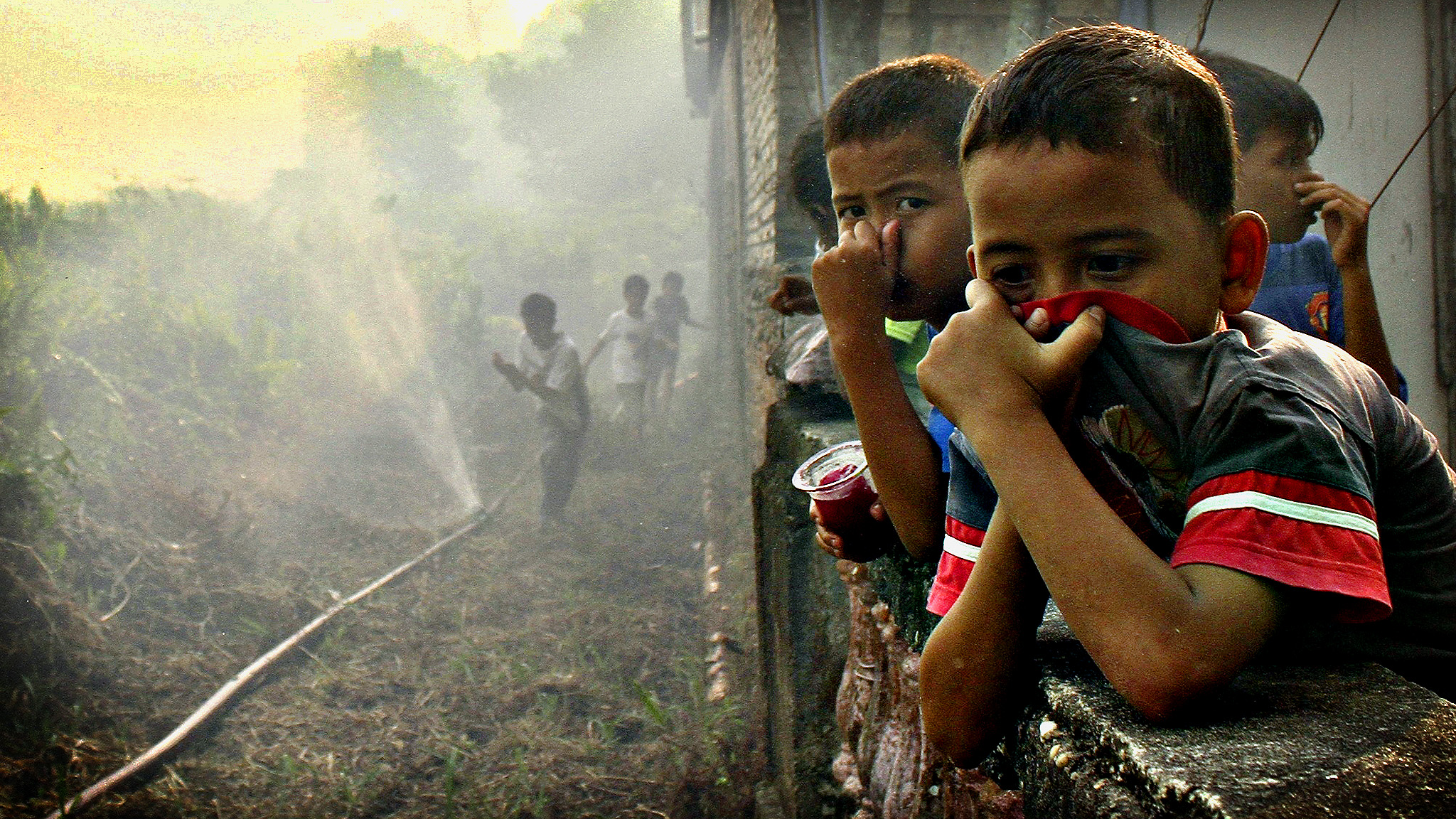Haze like the trans-boundary haze in 2015 impacted Indonesia as well as countries in South East Asia (SEA) such as, Singapore, economically. These economic impacts are estimated as it is hard to exact the degree or significance of haze on a country’s economy. However, government of these countries confirmed that the haze did indeed impact economies of countries in the region.
Haze
Social
Standard
Children cover their noses near burnt land in Marpoyan Damai sub district, in the outskirts of Pekanbaru, in Indonesia’s Riau province June 20, 2013
Haze has led to many social impacts in Indonesia as well as countries in the South East Asian region.
Indonesia greatest impact has closest to the haze. Many homes of the vulnerable- young, elderly and pregnant – had to be relocated, causing inconvenience for them. Besides that, the education of school children were affected as many schools had to be close due to hazardous levels of haze. Businesses and schools across the region close due to the haze, crippling many low-income families and prompting them to fall back into poverty. Approximately 5 million students have been impacted by school closures in 2015.
Haze forced school closures for up to 34 days, resulting in USD 34 million in costs. 14 In some instances, schools closed for weeks at a time, obliging teachers to accommodate take-home assignments. Conditions were worst in October 2015, impacting 24,773 schools and 4,692,537 students. Child-care costs and foregone wages increase when parents must care for children normally in school. These long-term, sustained school closures could contribute to weaker graduation rates if reclaiming lost school days becomes burdensome.
I had personally experience haze during my school days in secondary school and junior college. The impact on which haze had on our school curriculum was harsh and classes had to be relocated to air-conditioned rooms and some classes like Physical Education (PE) even had to be cancelled. Both events were on the year of my major examinations – O’levels and A’levels and many students, including myself, were anxious if the haze would affect our sitting for the examination. Schools did not close despite the PSI hitting to a high of over 400 (hazardous) in 2015, however, schools were prepared in the case that closure of schools were to happen.

Hardware shop Home in Clementi put up a sign announcing that it was giving away free masks to the elderly and children. PHOTO: THOMAS CHIA
Despite all the negative impacts, it has brought about the “Singaporean spirit” and sense of community in Singapore as organisations and people give out free mask to fellow citizens. While there were reports of people cashing in by re-selling N95 masks at a higher price during the last haze crisis in 2013, one hardware shop is doing the exact opposite this time round.
Local kindness movement Stand Up For Singapore kick started a fund-raising campaign called “I Will Be Your Shelter” to buy air purifiers and filters for the elderly and needy in the North Bridge Road area. It raised about $6,000 through crowdfunding site Indiegogo and donations as of October 2015 and distributed 40 air filters and 10 purifiers to the residents on September 19.
Resources:
http://blogs.ft.com/photo-diary/tag/lee-hsien-loong/
http://pubdocs.worldbank.org/en/643781465442350600/Indonesia-forest-fire-notes.pdf
Haze
StandardFig 1. Singapore’s Marina Bay shrouded in haze.
Haze is a concentration of smoke, dust, moisture, and vapour suspended in air that is enough to impair visibility. Haze pollution can be said to be “transboundary” if its density and extent is so great at source that it remains at measurable levels after crossing into another country’s air space.
Singapore has been experiencing severe transboundary haze pollution from as far back as the 1960’s due to forest fires in Indonesia. More recently in 2015, prolonged dry weather conditions led to escalations in hotspot activities and the region experienced unprecedented severity and massive geographical spread of the smoke haze affecting various countries, including Singapore, Malaysia, Thailand, the southern part of Philippines and the northern part of Laos. Millions of people were affected by the haze, which included 19 deaths in Indonesia.

Fig 2. Fireman putting out forest fire in Indonesia
The forest fires in Indonesia are caused by corporations as well as small-scale farmers that practice slash-and-burn to clear vegetation for palm oil, pulp and paper plantations. Once lit, the fires often spiral out of control and spread into protected forested areas and peat. Peat is accumulation of partially decayed vegetation or organic matter found in natural areas such as peatlands.

Fig 3. Smouldering peatland fire.
Peat consists of high carbon content and once ignited by a heat source it smoulder, which means it burns but with no flame. These smouldering fires may be undetected for very long periods of time, creeping through the underground peat layer. These fires are especially hard to put out and are a significant contribution to haze.
The annual haze at its largest can reach up to hundreds of kilometres across. The haze can be made worse by dry seasons, changes in wind direction and poor precipitation. Haze is also more pronounced under more sunlight, which is abundant in the region, as sunlight accelerates photochemical reactions.
Haze pollution originating from large-scale forest and land fires is characterised by a high concentration of particulate matter, which, among other effects, reduces visibility. Due to the specific emission characteristics of land and forest fires, haze is predominately made of very fine particles with a diameter of less than 10 mm. While coarse particles flush out of the atmosphere within several hours up to a day, fine particles have the longest residence time (up to weeks) in the atmosphere and travel extensive distances (hundreds to thousands of kilometres). Their elimination out of the atmosphere is mainly due to rain.
References
www.haze.gov.sg
http://www.earthobservatory.sg/news/earth-science-week-feature-understanding-science-behind-singapore%E2%80%99s-haze
http://eresources.nlb.gov.sg/infopedia/articles/SIP_2013-08-30_185150.html
http://www.straitstimes.com/singapore/environment/haze-in-singapore-a-problem-dating-back-40-years
http://www.bbc.com/news/world-asia-34265922
haze.asean.org


